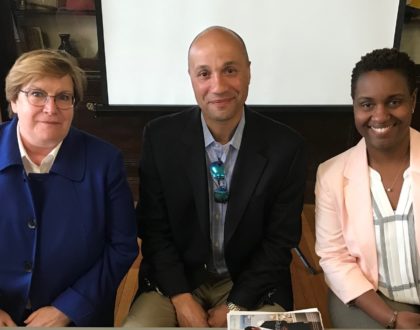Workforce Development: Educating the Workforce of the Future

In its simplest form, the concept of Workforce Development is one that may seem counter to traditional education pathways. It can easily become a situation of either or – either go into the workforce or pursue secondary and higher education. In today’s society, however, the growth of Workforce Development initiatives and programming are intrinsically tied to education – in particular secondary education – and the two are far from mutually exclusive. The Annie E. Casey Foundation has called for workforce development strategies that both prepare the worker and create the conditions where that worker’s success is attainable. This requires education, nonprofit and corporate leaders to work collaboratively.
Within the LeadBoston curriculum, it’s this connectivity and intersection that prompted the May Program Day, titled School Choice and Workforce Development. A robust, expert panel was invited to speak on the connections and efforts being made across sectors to create more fluid relationships and pathways. The 2018 class heard from Josh Bruno, the School-to-Career Director at Boston Private Industry Council (PIC), Melodie Knowlton, Head of Vertex Learning Lab, and Cecile Regner, the Interim Vice President of Academic and Student Affairs at Roxbury Community College.
 The discussion was equal parts informative and motivational, in part because of the candidness of all three panelists and in part because of their pre-existing relationships with one another. There was an authenticity and transparency to the conversation that spoke to how these leaders – both as individuals and within their organizations – are deeply committed to creating as many opportunities as possible for youth (and in RCC’s case young adults) in Boston. Many of the professionals within the LeadBoston program left day with a stronger understanding of what goes into creating and maintaining successful partnerships and with tools and resources to incorporate into their own organization’s Workforce Development programming.
The discussion was equal parts informative and motivational, in part because of the candidness of all three panelists and in part because of their pre-existing relationships with one another. There was an authenticity and transparency to the conversation that spoke to how these leaders – both as individuals and within their organizations – are deeply committed to creating as many opportunities as possible for youth (and in RCC’s case young adults) in Boston. Many of the professionals within the LeadBoston program left day with a stronger understanding of what goes into creating and maintaining successful partnerships and with tools and resources to incorporate into their own organization’s Workforce Development programming.
“This is [your] future workforce,” said Bruno. “But also, these are the people who will be putting money in [your] pockets.” PIC defines itself as a school-to-career intermediary organization that brings together employers, educators, and workforce organizations, often by industry sector, to help guide the agenda for education and workforce preparation. For Bruno, one of the key factors of a successful Workforce Development partnership is a deep sense of investment from organizations. Part of his job is to ensure that all of PIC’s partners have a concrete understanding that these internships are about developing a talent pipeline, not a quick source of labor. This requires an increased level of buy-in from senior leadership of employers, who must create a detailed job description for interns and appoint a dedicated number of supervisors to be responsible for every minute of the students’ time. Bruno also emphasized the need for both education institutions and businesses to be aware of the challenging transitions that students experience during their work placements. For many, it’s their first time in a professional setting and students can find the race, class and age demographics in many workplaces difficult to navigate.
Having transparent conversations with students on these issues is especially important to Knowlton, who is a role model for young women in the STEM field. “I love the fact that in my role, I get to work with the students. As a black woman, I get to break that wall in a professional setting and say, ‘let’s have a real chat.’” Knowlton and the team at Vertex rely on the support provided through their partnership with PIC to prepare student workers for the economic and racial inequities they may be faced with when entering into a professional setting. She encouraged the LeadBoston class to be thoughtful in the planning phase of programming and to be mindful about how to support interns with skills development while also creating an inclusive culture where they can be successful. It requires high touch support on both sides of a partnership and frequent communication amongst partner organizations to identify and address potential biases and pitfalls before they derail a partnership.
It’s one particular bias that makes entering into the workforce especially difficult for Regner’s students at Roxbury Community College. A high percentage of students at RCC are over the typical 18-22 college age, which is a consistent barrier when helping them to secure internships. Regner spoke passionately about just how unfounded these age biases are. Of older students, “They’re serious. They are going to be good employees when they come to you.” She challenged employers to think creatively about how to provide work placement opportunities for older students and named the critical importance of paid internships and flexible hours, especially for those who have families to support and who are already balancing full time jobs and classes.
Perhaps the biggest highlight of the hour long panel discussion is the notion that Workforce Development is a partnership, not a financial exchange. “It’s possible to throw money at the problem,” says Knowlton. “But throwing money isn’t enough. It’s about asking what the needs are.” For any Workforce Development programming to be successful, communication and an articulation of needs is vital so both parties are able to have a shared sense of expectation that ultimately keeps the most important stakeholders – the students – at the forefront.



